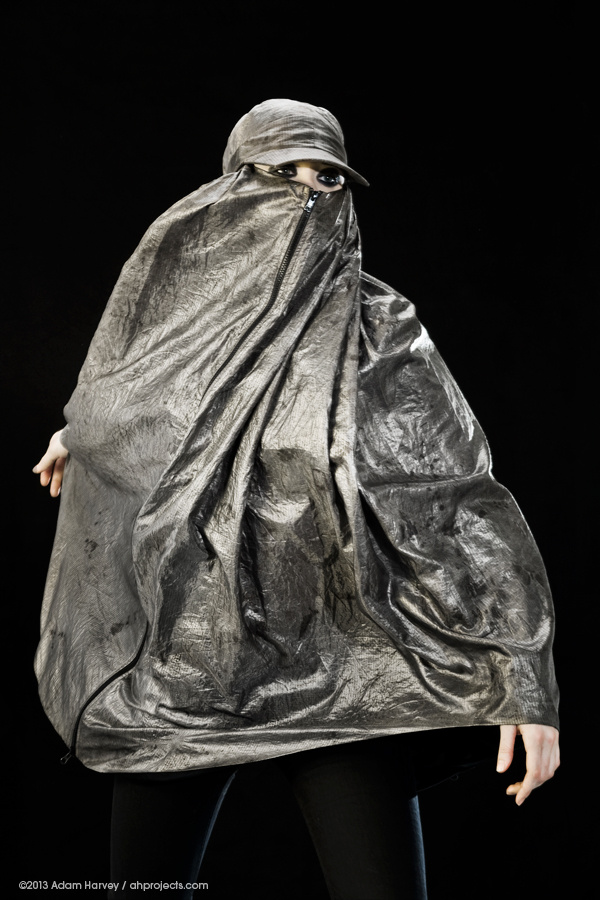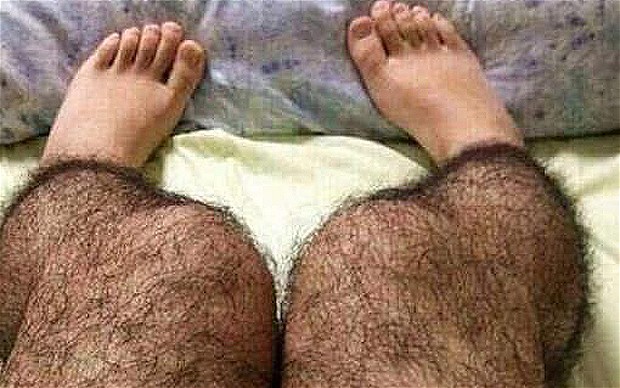
As debate over the use of unmanned aerial vehicles in the U.S. rages on, a fashion designer introduces clothing that blocks drone-mounted infrared cameras.
As the U.S. government draws up plans to use surveillance drones in domestic airspace, opposition to what many consider an unwarranted and significant invasion of privacy is mounting across the country, from rural Virginia to techopolis Seattle. Although officials debate anti-drone legislation at federal, state and local levels, one man is fighting back with high-tech apparel.
A New York City privacy advocate-turned-urban-guerilla fashion designer is selling garments designed to make their wearers invisible to infrared surveillance cameras, particularly those on drones. And although Adam Harvey admits that his three-item Stealth Wear line of scarves and capes is more of a political statement than a money-making venture, the science behind the fashion is quite sound.
“Fighting drones is not my full-time job, but it could be,” says Harvey, an instructor of physical computing at Manhattan’s School of Visual Arts and the creator of the CV Dazzle project, which seeks to develop makeup and hairstyles that camouflage people from face-recognition cameras and software.
Harvey’s newest medium, metalized fabric, has been around for more than 20 years. It holds in body heat that would burn bright for infrared cameras—a characteristic that could prove attractive to those who do not want unmanned aerial vehicles spying on them.
Metalized fabric
Metal is very good at absorbing and scattering infrared light, says Cheng Sun, a Northwestern University assistant professor of mechanical engineering. In that sense there is nothing exotic in how metalized fabric works—it “would strongly attenuate the [infrared] light,” he says. The metal would dissipate heat to surroundings as well, making the wearer harder to pinpoint.
To date, the fabric has primarily been used in tape and gaskets to protect electronics and communications equipment from static electricity and electromagnetic interference, according to Larry Creasy, director of technology for metalized fabric-maker Laird Technologies, based in Saint Louis.
Here’s how metalizing works, at least at Laird: Woven fabric, commonly nylon or polyester, is coated with a special catalyst—a precious metal Creasy declined to specify—that helps copper bind to the fiber. Once dry, the fabric is submerged in a copper sulfate–plating bath and dried. A nickel sulfamate bath follows to help the finished fabric withstand the elements and abrasions. The result is a flexible, breathable fabric that can be cut with ordinary tools but that protects against electromagnetic interference and masks infrared radiation, Creasy says. The process adds weight to the original fabric. An untreated square yard of nylon weighs about 42.5 grams. Treated, the same patch weighs more than 70 grams.
The fashion
Harvey’s fabric is coated with copper, nickel and silver, a combination that gives his scarves, head-and-shoulders cloak and thigh-length “burqa” a silvery and “luxurious” feel. The material blocks cell signals, as well, adding an element of risk to tweeting, texting and other mobile activities, as the wearer must break cover to communicate.
Stealth Wear is sold only via a U.K. Web site. The burqa goes for about $2,300, the “hoodie” is $481 and the scarf is $565—luxury items, but so, too, is privacy today, Harvey says.
The impetus
The high cost and limited availability are significant drawbacks—Harvey says he’s only sold one Stealth Wear item online, a scarf. But the Federal Aviation Administration (FAA) predicts 10,000 commercial drones will ply domestic airspace by 2017—almost twice the that of the U.S. Air Force’s current fleet of unmanned aircraft. The number of drones flying in the U.S. today is hard to pin down because not every company and agency that gets FAA approval to fly a drone actually puts one in the air. In fact, 1,428 private-sector and government requests have been approved since 2007, according to the FAA. A Los Angeles Times report states that 327 of those permits are still active. Meanwhile, President Obama signed a law in February 2012 that gives the FAA until September 2015 to draw up rules that dictate how law enforcement, the military and other entities may use drones in U.S. airspace.
As of October 2012, 81 law agencies, universities, an Indian tribal agency and other entities had applied to the FAA to fly drones, according to documents released by the FAA to the Electronic Freedom Frontier following a Freedom of Information Act lawsuit. Government entities as diverse as the U.S. Department of State and Otter Tail County, Minn., are among them.
Discomfort rising
Although Harvey’s anti-drone fashions are not currently flying off the shelves, he could soon find himself leading a seller’s market if recent events are any metric:
•The Charlottesville, Va., city council has passed a watered-down ordinance that asks the federal and commonwealth governments not to use drone-derived information in court. Proponents had sought to make the city drone-free (pdf).
•Virginia, Minnesota, Oregon, Montana, Arizona (pdf) and Idaho legislators are trying to at least regulate or even prohibit, drones in their skies.
•Seattle Mayor Mike McGinn returned the city’s two surveillance drones after a hostile public reception.
•A bipartisan pair of U.S. Representatives has introduced legislation to limit information-gathering by government-operated drones as well as prohibit weapons on law-enforcement and privately owned unmanned aerial vehicles.
Drone advocates defend the use of the technology as a surveillance tool. “We clearly need to do a better job of educating people about the domestic use of drones,” says Ben Gielow, government relations manager for the Association for Unmanned Vehicle Systems International. Gielow says U.S. voters must decide the acceptability of data collection from all sources, adding, “Ultimately, an unmanned aircraft is no different than gathering data from the GPS on your phone or from satellites.”
GPS does not use infrared cameras, however, and satellites are not at the center the current privacy debate brewing in Washington—factors that could make Harvey’s designs all the more fashionable.
http://www.scientificamerican.com/article.cfm?id=drone-proof-anti-infrared-apparel&page=2









